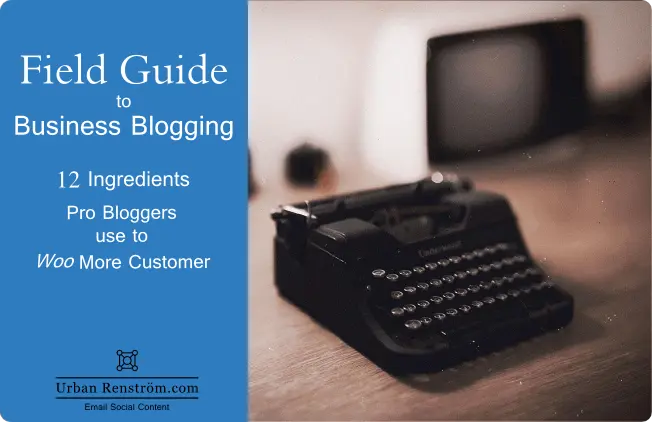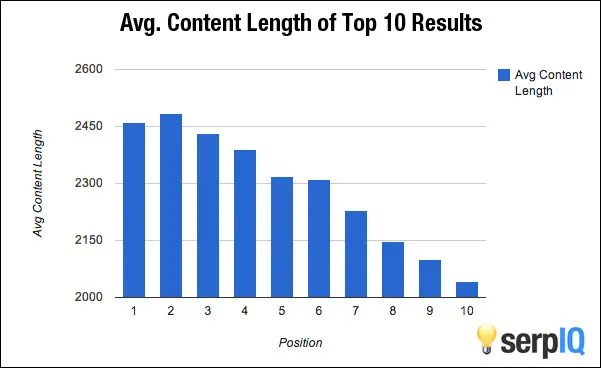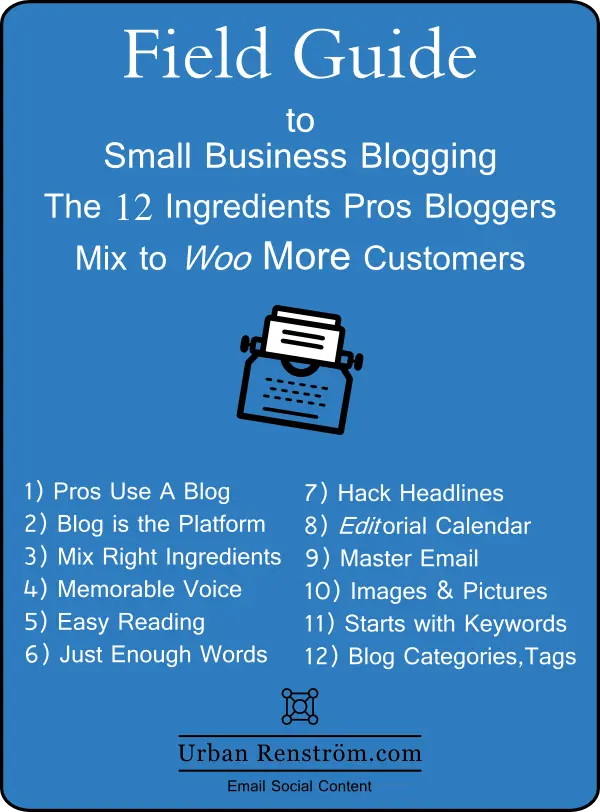Field Guide to Business Blogging — 12 Ingredients Pros use to Woo More Customer (and you are Ignoring)

Business Blogging woos customers.
That’s what we’re all trying to do. Aren’t we?
Make people feel special. Treat them well, and make their problems go away.
Right? Right.
UPDATED NOTE: February 2021, This post was updated for content, readability, speling, gramer, syntext, context and the continuous updating and understanding of Digital Marketing.
We woo people to speed up the Know, Like, and Trust business cycle.
Why do so many business hammer their followers with high-pressure emails, repetitive ads and use high-pressure sales tactics?
I don’t know, but, but, there is a better way than the Mad Men ways.
The better way is to help. Be a teacher, a friend, and guide people along thier customer ‘journey’. Follow and use Eugene Schwarts 5 stages of the buyer’s cycle as your content marketing guide.
This is the wooing way and wooing is the winning way.
Don’t worry, this is Urban Renström, there is always science and research involved in everything I talk about, teach, and demonstrate.
Business Blogging is simply Offering Advice and Helping
Marketing used to be about creating a myth and telling it. Now it’s about telling a truth and sharing it. –
Marc Mathieu, Uniliver
Business Blogging pros put their ‘make them feel special’ wooing magic on a blog. Are you ready to step up and help to woo people? Good and good.
Let us peel back the covers and revel the ingredients of a business blogging Pro bloggers blog.
1) A Website Or Is It A Blog?
A business blog is for search engines (getting found), newsletters (email marketing) is for people
Chris Brogan see min 16:45
Business Blogging pros publish original content on their blog. Not on Medium, Facebook, Slideshare, Tumbler or Twitter. Yes, these other networks are easy and quick and are where people hang out. But, first, they published on their own blog.
Publishing on other places is problem numero uno.
These countless other places are rented ‘land’. Someone else owns it. Renting is not a problem. Getting the rug pulled out from under your feet and your business is the problem. Changing the rules is what landlords do.
Business Blogging pros figured out this years ago and keep their blog as the home base. So should you.
Is there a difference between website and a blog?
Characteristics of a Business blog are:
- Separate ‘articles’ called ‘posts’
- Normally displayed in reverse chronological order
- Stitched together with common theme or purpose
- Updated regularly
- Has a commenting system for feedback and comments
- Informative, educational or edutainment
- Crawled by internet spiders
- Uses a CMS, content management system
- Few business have blogs
A website is:
- A number of fixed pages related to product, services or cause
- Very formal and professional
- No commenting system
- Just about everybody has a website
The Inbetweeners — A Blog as a Website or Website with a blog.
The first blogs were simple on-line journals or diaries. Current blogging platforms have developed far beyond the simple.
I use this site for business blogging and my website. It is WordPress, has a blog (and a Podcast) and I have static (stuffy, professional) fixed pages and soon I’ll be offering online courses.
So what is blogging and should you care?
2) Business Blogging As the Hub For your Content
Content Marketing (via Blogging) is about earning familiarity, trust, and (building) relationships –Rand Fishkin
Blogging for client acquisition attracts people, and educating, helping people at every stage of their buying journey.
These wooing articles match the four stages of people buyers journey — Attraction, Engagement, Conversion and Lifetime Value. They relate to the unaware, to aware, to interested, and taking action stages of the journey.
Not any slapstick, begging ‘Please buy from me because I am good‘ content will do, oh no. Pro bloggers write deep, informative, content to woo people. You should also.
But, how do articles woo people?
- Business Blogging Builds Relationships — A business blog is the perfect place, perfect place, for people get to know you, like you, and trust you. Your blog articles are the extension of you and your business. You can use your blog to share thoughts, ideas and insights.
- Business Blogging sets you as an Authority — Blog for sales automagically makes you a subject matter expert in your niche. Wait! What? Yep, business articles make you an authority. Not overnight, not easily, but, yes. Publish high quality, original, informative and entertaining content and people will bestow authority status on you. But, you must give quality to get authority. Do you want to be an authority?
- Business Blogging Get You Found [in Search] — Every blog post has a separate web address (a URL). Each URL is a wide-open door inviting people onto your blog and website. So, the more address you have the more chances of getting found. Like magic your 100, 200 or 1000 blog posts represent that many wide-open doors people can walk through into your business. Oh my. Oh my. The possibilities and competitive advantage should be spinning your hat on your head.
- ‘Power to the People’ Business Blogging has Replaced Sales — Well not always, but, in many situations yes. In the ‘mad men’ days, sales controlled the power in the sales/buyer relationship. Sales were the gatekeeper of knowledge and spoon feed information to people. The internet turned this on its head. Information became free and people got smart and asked for more information. Bloggers answered and produced more.
Can articles help buyers make decision? Oh yes. Because:
- Getting found in search it’s more trustworthy than advertisements
- Your content positions you strategically as a resource for answers and therefore,
- You are helping and wooing, and
- You are in the running as a supplier
Blogging, builds authority, creates wide open doors, to get found in search and people are actively looking to get their questions answered.
Blogging does all that!? Yep.
So what other ingredients do we need to woo customers?
3) Mix the Right Content Ingredients to woo
- Pros write for an audience and publish what people want to read
- Pro bloggers give freely knowledge and their expertise
- Pros publish on a schedule. Like newspapers and magazines
- Link out and inside their article
- Articles are scannable, use short sentences and short paragraphs, with enticing subheadings
- Pros use social sharing buttons
- Pros write for people 1st and search engines 2nd
- Pros avoid sales copy – keep that for email marketing
4) Writing Voice — Will I remember?
“I own a sieve.
It’s called my brain.
I distinctly remember listening, then reading a book and then months later I listened to it once again. And I couldn’t remember almost 90% of what I’d read and, mind you, listened to, earlier” — Sean D’Souza
Or
“Now, before we go any further, let it be said: there’s a certain amount of Fake Emotion on the internet.
Everyone’s excited about their new thing. Everyone’s thrilled by what they are about to tell you. Everyone’s confident that no matter what you’ve tried, this time it will work.
Meh. Meh, I say.” — Stella Orange
Both writers have distinct styles and show their personality. A blogging voice is really your personality coming alive on stage or your page.
Your Voice — Use one your Audience Can Relate With
Use your personality, be identifiable and stand for something. Stand for something so you separate yourself from the noise of the crowd. And as you do this many will repel from you and many people will gravitate towards you.
So how do you find your writing voice?
- Take a stand, but, not obnoxiously. Avoid politics and religion as they are divisive.
- Be unique in your words choices and phrases.
- Write like you talk:
- Natural writing attracts readers who are like-minded with you
- Your tone and voice will self-select your audience. A very good thing
- Readers are more engaged with a unique viewpoint and stories and can relate
- Uniqueness builds bonds with readers. Bonds can turn into trust
- You will have more fun writing as yourself than as a stuffy corporate writer
Your writing ‘voice’ is your Unique Selling Proposition and is your differentiation between you and your competitors.
5) Reading Level – Easy to Read is Hard to Write
Strive to write at primary or post primary level reading level when blogging for business purposes.
Our everyday reading in newspapers, emails, are written at that level offering a comfort factor to your readers. Not alone you writing will be easier to understand.
The ‘Wordpress SEO’ plug-in by Yoast SEO ( one of the first to install) takes care of many aspects of your blog SEO and it magically assesses your writing with a Flesh Reading Ease test score. MS Word can also check readability.
Use the feature as feedback on your writing and adjust your accordingly.
6) How Long is Enough – Does Blog Post Length Matter?
Thin content is not about word count. It’s about quality & user engagement — Google’s +John Mueller & Team
The squishy and jelly answer is a blog post should be long enough to answer the question and quelling the objection, for that point you are making.
Seth Godin uses 40 word and fully explores ideas. Avinash Kaushik blog, Occam’s Razor, word count is in the thousands. Yet, each explores and explains completely.
And I learn from each.
Business Blogging Thin Content and Bounce Rate
Bounce rate is the term used to describe the time between when visitor arrives at your site and when they leave. A low bounce rate equals staying on your blog longer.
Google, Bing may uses bounce rates as one ranking factor (∼200 in total) in their search algorithm. Facebook also uses a similar metric as a content quality signal. But, why care?
Low word count and high bounce rates often, but not always, correlates with low visitor engagement. Low visitor engagement, in Google and Facebook’s eyes is ‘thin’ content. Thin content is synonymous with spam.
Thin and spam does not a customer woo.
Page 1 of Google is filled with High Word Count Articles — Research and Insights

serpIQ studied 20k keywords. One of the conclusions was articles in top 10 search results had word count of 2000 or greater.
Higher in the SERP’s equals more click to your page. More clicks is more visitors. More visitors, more subscribers and more revenue.
A different study looked at 500 blog posts on the Moz.com blog. This study found a correlation (not causation) between longer blog posts and the number of inbound links.
Ok, but, who cares if website gets links? Word count is not enough to rank in search. Inbound links show search engine other sites believe your page are useful.
Rae Hoffman stated it best:
Google doesn’t exist to make your website popular, Google exists to rank popular websites – Rae Hoffman
How does Google know if a website is popular? You are clever girls and boys – links. Specifically, the number of inbound links a blog post receives. Popular blog posts (as voted upon by inbound links, and ∼200 other factors) can determine if you are on page 1 or 10 in Google search.
However, wooing people is not about word count or links or ranking. It is more helping people understand their problem and moving them along their buyers journey to solve their problem. This is where uses experience help.
Popular blogs posts gets more links, more links equals higher ranking in search. Higher ranking gets you more visitors and more changes of wooing people to take action to buy your stuff. A virtuous cycle.
So, yes, links matter. Before you get any links your headline is the first step to wooing people.
7) A Business Blogging Headline is the Ad for your Article
David Ogilvy, invested 80% of his client’s money on the title of an ad.
Upworthy creates 25 headlines for each post. Than A/B tests the top 5 for click-ability and choose the best.
But, why care about the headline? A headline is not the meat of article? No it is not, but, the goal of a headline is to get you to click on the link, or open the magazine, or pick up the paper and read more. The headline grabs attention and get people to read more.
For example:
- “Robin Williams Had A SHOCKING Demand While On Set That No One Knew…Until Now”
- “Some breakfast cereals are ‘as sugary as 7 chocolate fingers’”
- “Chemists discover how to unboil an egg”
What do these titles have in common? These are catchy, engaging, promising, unexpected, and surprising.
Copywriters, good copywriters, place a lot of weight on the shoulders of a headline. For good reason. A headline is hors d’oeuvres and sets the tone for the rest of the readers experience.
The Opposite is also true
If you make outrageous claims in your title, a.k.s. Click Bait, and don’t back up those claims. Then you will loose credibility, trust and a readers. Forever.
What Makes A Good Headlines for Business Blogging?
More than good looks and guess work. Actually. Headline formulas and templates exist.
I pass every headlines through Jon Morrow’s blockbuster headline 3 questions test:
- “What is in it for me?” the reader will ask this subconsciously
- Will your headline keep them up at night worried or excited?
- Are there power words in the title.
Nail 2 out of 3 and you have a winner. 3 out of 3 and it’s a viral blockbuster headline. Simple as.
Care for a head start on your headline crafting career?
Headline Hacks is downloadable cheat sheet from Jon Morrow on creating headlines.
The Emotional Marketing Value Headline Analyzer test headlines for ‘Emotional Marketing Value’.
102 Headline-Writing Formulas by Chris Garrett, is 102 headlines formulas.
How to Write Magnetic Headlines by Copyblogger is a How -To article.
Why Headlines Fail by Sean D’Souza. Very instructive and useful.
Tweak your Biz title generator is a blog post title generator and you can download the text file, my test yielded 343 headlines.
Potent Content Idea Generator outputs amazing and funny headlines and content ideas.
Jon Morrow’s Power Words post Read this post, use power words and watch your writing explode with viral greatness. Also, the comments of this post are worth the read alone and will double your power word count.
8) Business Blogging Editorial Calendar Keeps your Wooing on Track
“Marketing is no longer about the stuff that you make, but about the stories you tell.” – Seth Godin
Content marketing is really just telling someone about an idea you had – Sonia Simone
Content will “position your company not just as a seller of stuff, but as a reliable source of information.” Ann Handley, author Content Rules.
Content & Editorial Calendars as ‘Guide Stars’
Editorial Calendar help organise when to write it.
Both calendars are needed to write and publish effectively to woo prospects and build your business.
9) The Email Bribe – The Link Between Wooing and Sales
A blog is for search engines, email ‘newsletter’ is where relationships are made – Chris Brogan
Pro bloggers know deep relationship and trust is formed with email. Email is where people buy from you.
Email is 40x more effective for acquiring sales than Facebook and Twitter combined. 91% of all US consumers use email daily. Email users order 3x more often then social. The order value via email is 17% higher than social. Ignoring email is leaving money on the table for your competitor to collect.
Effective email marketing is about about getting permissions from people. You need a bribe to get an email address. Yes, a bribe, a lure. an irresistible lead magnet.
‘Join my newsletter’, nowadays, is synonymous with spam is poor incentive and has very low conversions. Yes, you see plenty of ‘Join my Newsletter’ in the blogosphere. However, you can do so much better (this blog use one!).
However, this lead magnet must have significant perceived value to the reader. Jon Morrow of headline hack fame, suggests, an eBook should have sufficient value that the retail price would be $100. I would agree. When your funnel is funneling and working effectively then the LTV of 1 email is easily >$100.
Your bribe can be anything your audience values and desires. Inside the Field Guide to Irresistible Lead Magnet I walk you through loads of examples. Using worksheets I help you create your first high value irresistible lead magnet. Get your free copy of the Field Guide.
Lead Magnets can be:
- A blog post in PDF format
- A guide on how to select the proper colours for a room (if you’re and Interior Designer)
- eBook on how to achieve desired result
- A check list
- A fast-start guide
- A video series
- Coupon or discount codes
Building a large list of email subscriber is your business goal numro uno. Not because of getting more blog traffic, but because there is “money to be made with the list”. A list is asset for your business.
10) Business Blogging and Images, Graphs and Pictures
Every picture tell a story. 1000 words and all that.
Pictures stop em dead in their tracks. Your blockbuster headline gets the click, your blog post read and your irresistible lead magnet gets the email opt-in, and the wooing begins.
Pictures are the things which catch our eye and our attention and pull us in. Good pictures do anyway.
As you zoom past the daily clutter in Facebook and Twitter, think about what captures your eye? Cats, dogs, babies? Yes, but, they are visuals. Creating Photoshop quality visual is not difficult. But, essential for social sharing.
PicMonkey, Canva, and others will turn your simple sketches into a Photoshop masterpieces in minutes.
11) Business Blogging Keywords, Post Length, and Page 1 of Google
Earlier we saw your writing voice, headlines, and the reasons why article lengths matter. Also, how they all contribute to ranking your blog posts high in the search results.
But, getting found in search is begins with keywords. Keywords link what people are searching for and with your blog posts.
Like magic they do this.
On Facebook we are get entertained and don’t search, but, with Google we do search and with intent, e.g. “I Need A 30 Minute Chicken Receipt with White wine sauce”, how do I fix this broken zipper. The intent with search is finding an answer to a question.
Your blog post fulfills the intent of the person searching – “10 Easy Succulent Chicken Receipts On the Table in 30 minutes”
Finding and using the right keywords, and the right long tail keywords for your blog posts is a science and an art.
Pro bloggers research and select keywords expertly.
12) Business Blogging Categories And Tags for SEO
Pro bloggers woo people not just with headlines and pretty pictures. Oh no. You need to pull people from search if you want success.
A solid blog SEO foundation is central to getting found in search. But, not any farmers field stones or worn out cobblestones will do as foundations. Oh no, you need the right stones to build.
Those foundation stones are your blog categories.
Categories, keywords, site architecture, page load speed and other behind-the-scenes ‘stuff’ contribute to your website and blogs SEO. Categories are chosen by you. Categories are, often, single words or short phrases, and derivative terms related to your products and services. These categories are the main terms your blog content will be written about.
7-8 Categories is Ideal. Go crazy with Tags
Think of categories as different groups of dished in a recipe book. Those receipts could be grouped under the main dishes:
- Beef
- Poultry
- Pork
- Fish
- Lamb
- Vegetarian
- Pasta
Each ‘category’ (beef) has hundreds of individual receipt, (blog posts), e.g. Beef Wellington, BBQ beef, slow cook, Cajun beef, hamburgers, Shepard’s Pie, etc.
Tags
Tags are higher level attributes cutting across the articles (or receipts). Tags link to other receipts using the same attributes.
Each individual ingredient is a Tag. So a Beef Wellington receipt use Tenderloin, puff pastry, a pancake (flour, butter, water, milk, egg, salt), spinach, potatoes, and asparagus. Each a tag.
So, if a chicken receipt with asparagus and I wanted to find other receipts using asparagus I would simple click on ‘asparagus’ tag, and all blog post with ‘asparagus’ would be displayed. But, asparagus is not the central ingredient in the receipt, therefore not a category.
Choosing the right categories for your blog is requires a research and thought.
12 Ingredients to Woo Clients and Convert into become Customers.
Which ingredients would you mix differently?
Let’s continue the conversation in the comments.
Image Credit





Not worth how much I paid to upgrade. Trying out INK for ALL because I had a top customer service experience with them.